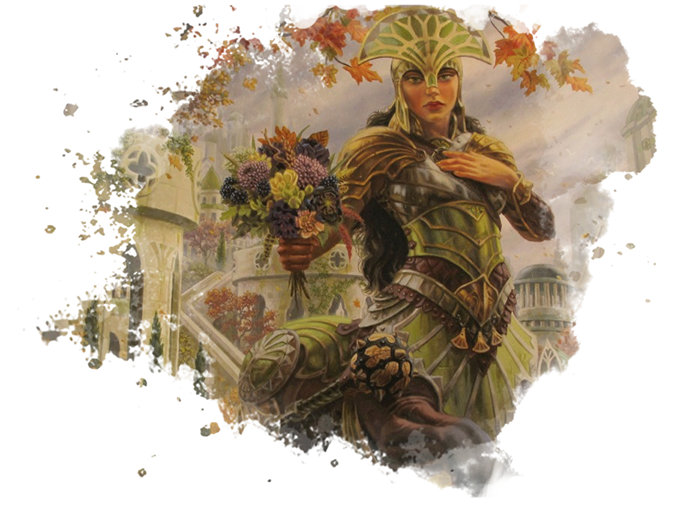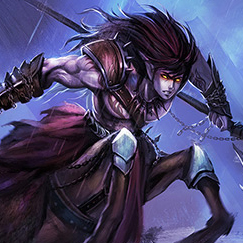Etymology and definition
Centaurs are classified as kentauros which is regarded as being of obscure origin. The etymology from ken + tauros, 'piercing bull', was a euhemerist suggestion in rationalizing text on old Human mythology which referenced Ioras, God of Victory.
Biology
Anatomy and Physiology
Most aspects of Centaur biology are closely related to both their humanoid counterparts, and the lower animalistic half of the specific animal, as not all centaurs are half horse.
The centaur hosts a primary and secondary heart to pump blood through its rather large hybrid system. If one should fail, the other can take over but at a cost; The centaur is severely crippled and cannot exhert himself for extended periods of time. There have been accounts of a centaur's primary heart (the one within the human chest cavity) being destoryed through battle and living a long and healthy life afterwards, albeit at the expense of never being able to gallop for more than a minute.
They boast two synchronized diaphrams to be able to inhale larger amounts of oxygen to compensate for their bodies. Centaurs have a human stomach that is required to digest an omnivore's diet, but it is located within the lower half and is larger than a normal humans to be able to consume more calories.
Every other organ and their skeletal structure is largely what one can expect if you mixed the two species together.
Life Cycle and Sexuality
Centaurs have fully functional sexual organs up until a certain age late in life, usually up until around the age of 80. A female who is impregnated will carry the child for about a year before she will give birth. The centaur baby is capable of moving and running on its own right after birth, and has some independant agency because of it. However, their human brains are still very underdeveloped and must still be carefully watched over until about the age of six. Centaurs are incapable of interbreeding with other species, including their respective animal species and humanoid species; They are only able to breed within their own.
A centaur reaches maturity around the same age as humans at 18, and is considered fully mentally developed near the age of 25. The average centaur lifespan is around 100, with some centaurs living upwards to 150.
Diet
Centaurs are omnivores.
History
The centaurs origins stems from the splitting of Iroas and Mogis, wherein half of the most devout followers of the once whole god were given the form of the centaur, and the other half of minotaur. Centaurs are mostly classified as half horse, but there have been accounts of other animalistic species such as bulls being a part of their anatomy. The exact type of animal is largely dependant on where the individual's ancestors originated from.
Centaurs have largely been regarded as a very useful asset to any civiliation throughout most of history. They have served both human empires and elf tribes in many ways through agriculture assistance, logistical work, and most often through war. Centaurs have been used mainly as hit-and-run archers, able to keep their distance and circle their enemies while they pick them off with deadly accuracy. They have also been used as heavy calvary, clad in heavy armor and using couched lances to deliver devistating attack to break and shock enemy lines.
Very rarely do centaus actually allow an individual mount them unless through an emergency. Centaurs tend to agree that the act is demeaning and puts them on the level of the animals they share biology with. Exceptions have been recorded though, such as the Battle of the Red Plains, where small force of elves and Centaurs fought off a larger human and dwarf expiditionary force. The elves rode their centaur allies into battle, both weilding bow and arrow. The devistating accuracy of both elf and centaur along with their speed routed the force within a short time.
Modern centaurs still remain integrated well into society, and continue to avoid letting anyone but their closest friends ride them for any reason other than the most dire of circumstances.
Society and Culture
Centaurs enjoy the daily life of Ravnica with the rest of its citizens. Most guilded centaurs have joined either the Selesnya or the Gruul. It's far more common to see an unguilded centaur than it is to see a centaur in any other guild.
Selesnya Centaurs
Selesnyan centaurs are considered noble and peaceful protectors of the people. They help maintain reclimation zones and keep dangerous animals away from the urban sprawls. They are quick to respond to any danger and are more fearsome warriors when the need arises. They are inspiring and instill hope into their comrades with their elegant and almost regal appearance and battle prowress. They are extremly respected individuals deep within Selesnyan territory with some centaurs even having a personal aid part crowds of people for them. Further away from Selesnya influence though, fewer people will find the same respect and will treat these centaurs as equals at best.
Gruul Centaurs
Gruul centaurs are wild savages who revel in battle and destruction; they are larger than their Selesnya cousins, and though they are also part horse they have huge racks of elk-like antlers as well. A stark opposite to Selesnyan centaurs, these people bring about them a dreadful fear when one hears the thundering of their incoming hoofs. Their tactics are far more brutal, often choosing to trample and crush their enemies to leave an impression and a warning to any of their enemies. An obvious Gruul centaur will be met with distrust and fear by most ordinary citizens and become large targets in battle.

Centaur by SidharthChaturvedi
A Gruul Centaur
Language
Centaurs don't have their own language, instead they share whichever language they tend to congregate with the most.
Religions
Most centaurs tend to worship
Nylea, God of the Hunt for the relation of her and nature or
Iroas, God of Victory due to their belief that he is responsible for their existance.
Inter-species relations
Generally, centaurs can get along with most everyone on Ravnica. Their unusual shape can make for some awkwards interactions around the city and within structures, but for the most part no one should have too much trouble befriending one. Outside of emergencies, centaurs tend to only let their closest friends ride on their back, and even then it isn't all that common. Jumping on the back of a centaur without permission is a sure way of making a new enemy, or getting terribly hurt as they buck you off of them.






Comments